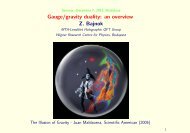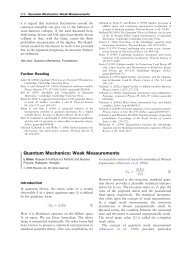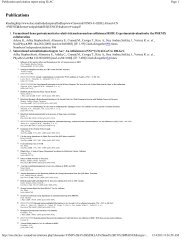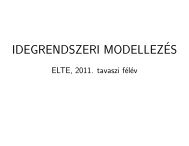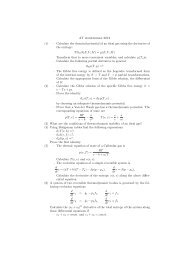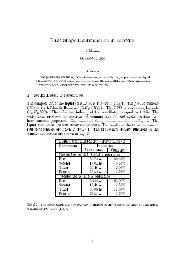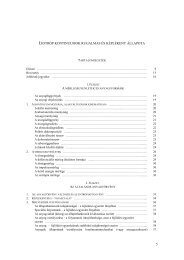Second Law of thermodynamics and the failure of rock materials
Second Law of thermodynamics and the failure of rock materials
Second Law of thermodynamics and the failure of rock materials
Create successful ePaper yourself
Turn your PDF publications into a flip-book with our unique Google optimized e-Paper software.
<strong>the</strong>oretical background as a direct <strong>the</strong>rmodynamic<br />
generalization <strong>of</strong> Griffith criteria in three<br />
dimensions.<br />
To demonstrate <strong>the</strong> differences a simple example<br />
is given here, based on <strong>the</strong> experimental data <strong>of</strong><br />
Brown performed on Wombeyan marble in biaxial<br />
experiments with brush plattens (Brown 1974).<br />
According to biaxial experiments, contrary to Mohr<br />
assumptions, not only <strong>the</strong> difference <strong>of</strong> <strong>the</strong> biggest<br />
<strong>and</strong> lowest principal stresses determine <strong>the</strong> strength<br />
<strong>of</strong> <strong>the</strong> <strong>rock</strong>: <strong>the</strong> influence <strong>of</strong> intermediate stresses is<br />
not negligible. Lade fitted his criteria with <strong>the</strong><br />
experimental data <strong>of</strong> Brown (Lade 1993).<br />
are not too important, because <strong>the</strong> <strong>failure</strong> surface is<br />
independent on <strong>the</strong> damage if it is sufficiently small.<br />
It can be seen on <strong>the</strong> figure that <strong>the</strong> <strong>the</strong>rmodynamic<br />
condition gives a piecewise continuous <strong>failure</strong><br />
threshold.<br />
Let us observe some important qualitative<br />
differences between <strong>the</strong> empirical <strong>and</strong> <strong>the</strong><br />
<strong>the</strong>rmodynamic criteria. The <strong>the</strong>rmodynamic <strong>failure</strong><br />
surface is a cross section <strong>of</strong> several surfaces,<br />
<strong>the</strong>refore it has some vertices. One <strong>of</strong> <strong>the</strong> vertices is<br />
on <strong>the</strong> hydrostatic axis for tensile stresses. It is<br />
similar to <strong>the</strong> construction <strong>of</strong> <strong>the</strong> Griffith-Murell<br />
criteria, where also some cross sectional surface was<br />
proposed (a very special one). The published data on<br />
this experiment <strong>of</strong> Brown is not sufficient to<br />
determine all <strong>of</strong> <strong>the</strong> <strong>the</strong>rmodynamic parameters (for<br />
<strong>the</strong> fitting we have chosen a suitable parameter set,<br />
considering some physical mechanisms).<br />
Measurements to determine <strong>the</strong> material parameters<br />
for a brittle <strong>rock</strong> <strong>and</strong> <strong>the</strong> compatibility with <strong>the</strong><br />
predictions on <strong>the</strong> dynamics are under way.<br />
σ 1<br />
σ 2<br />
CONCLUSIONS AND DISCUSSION<br />
Figure 2. Biaxial experimental data, criterion <strong>of</strong> Lade <strong>and</strong><br />
<strong>the</strong>rmodynamic <strong>failure</strong> envelope.<br />
Figure 2 shows <strong>the</strong> results <strong>of</strong> biaxial experiments,<br />
<strong>the</strong> corresponding fitted <strong>failure</strong> surface <strong>of</strong> Lade <strong>and</strong><br />
<strong>the</strong> <strong>failure</strong> surface proposed by <strong>the</strong> <strong>the</strong>rmodynamic<br />
stability condition. The empty dots denote <strong>the</strong><br />
experimental results <strong>and</strong> <strong>the</strong> broken line is <strong>the</strong><br />
threshold <strong>of</strong> <strong>the</strong> criterion <strong>of</strong> Lade with <strong>the</strong> parameter<br />
values m=1.162, η 1 =601500 <strong>and</strong> a=38.0. The<br />
<strong>the</strong>rmodynamic criterion results in <strong>the</strong> three elliptic<br />
curves. Their internal hull gives <strong>the</strong> boundaries <strong>of</strong><br />
<strong>the</strong>rmodynamic stability an denoted by <strong>the</strong> thickest<br />
line on <strong>the</strong> figure. The parameters are δ=0,<br />
k δ =10.9976, µ=50000, k µ =0.03, λ=0.14, k λ =0,<br />
ζ=100, β=11.2156, k β = 0 <strong>and</strong> γ= 0.0353352. Only<br />
three parameters are used for <strong>the</strong> fitting, <strong>the</strong> o<strong>the</strong>r<br />
non-zero parameters are calculated from <strong>the</strong> known<br />
properties <strong>of</strong> <strong>the</strong> material or estimated suitably. The<br />
initial damage vector is chosen as<br />
=(0.003,0.003,0.003), supposing a uniform<br />
directional distribution. The chosen particular values<br />
In this paper a <strong>the</strong>oretical concept <strong>of</strong><br />
nonequilibrium phase breaking is proposed as a tool<br />
to extend <strong>the</strong> frames <strong>of</strong> <strong>the</strong> phenomenological<br />
<strong>the</strong>rmodynamic modeling. As an application <strong>of</strong> this<br />
idea a particular phenomena, <strong>the</strong> microcrack induced<br />
damage is investigated in detail. A simple internal<br />
variable <strong>the</strong>ory is suggested, using a single vectorial<br />
internal variable <strong>and</strong> based on <strong>the</strong> most general<br />
second order approximation <strong>of</strong> <strong>the</strong> Gibbs free<br />
energy. We have seen that <strong>the</strong> model can be<br />
considered as a generalizations <strong>of</strong> <strong>the</strong> classical<br />
energetic Griffith model <strong>of</strong> <strong>failure</strong>. The boundary <strong>of</strong><br />
<strong>the</strong> domain <strong>of</strong> <strong>the</strong>rmodynamic stability is proved to<br />
be a generalization <strong>of</strong> traditional mechanical<br />
localization criteria. A comparison with empirical<br />
<strong>failure</strong> criteria showed that this simple model with<br />
<strong>the</strong>rmodynamic stability results in <strong>the</strong> best fitting to<br />
<strong>the</strong> available experimental data in a three<br />
dimensional stress space.<br />
The concept <strong>of</strong> <strong>failure</strong> deserves some attention<br />
from an experimental point <strong>of</strong> view. The material<br />
can be kept toge<strong>the</strong>r even when its internal structure<br />
is completely destroyed. First it was pointed out by<br />
Orowan 1960 analyzing <strong>the</strong> classical experiments <strong>of</strong><br />
von Kármán with Carrara marble. The marble<br />
became powdered, chalk like with large lateral<br />
pressures, which indicates a change in <strong>the</strong> internal<br />
structure. In this case <strong>the</strong> phase breaking is closely<br />
related to a real phase transition, <strong>and</strong> supposedly<br />
ano<strong>the</strong>r free energy can be introduced to characterize<br />
<strong>the</strong> powdered, frictional state.<br />
The dynamical properties <strong>of</strong> <strong>the</strong> phenomena are<br />
not investigated in this paper, but it is clear that our<br />
simple model can be considered only as a first



